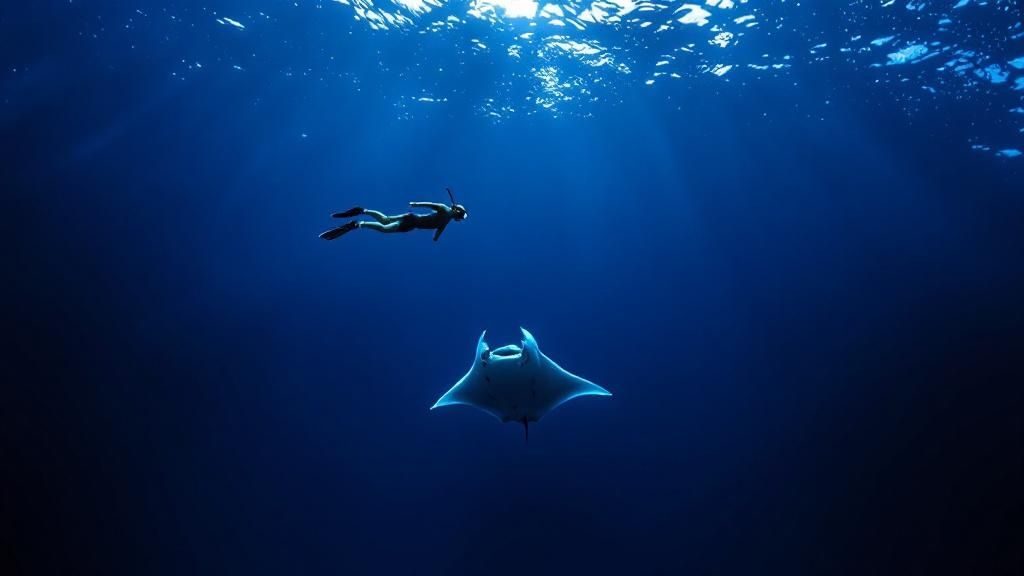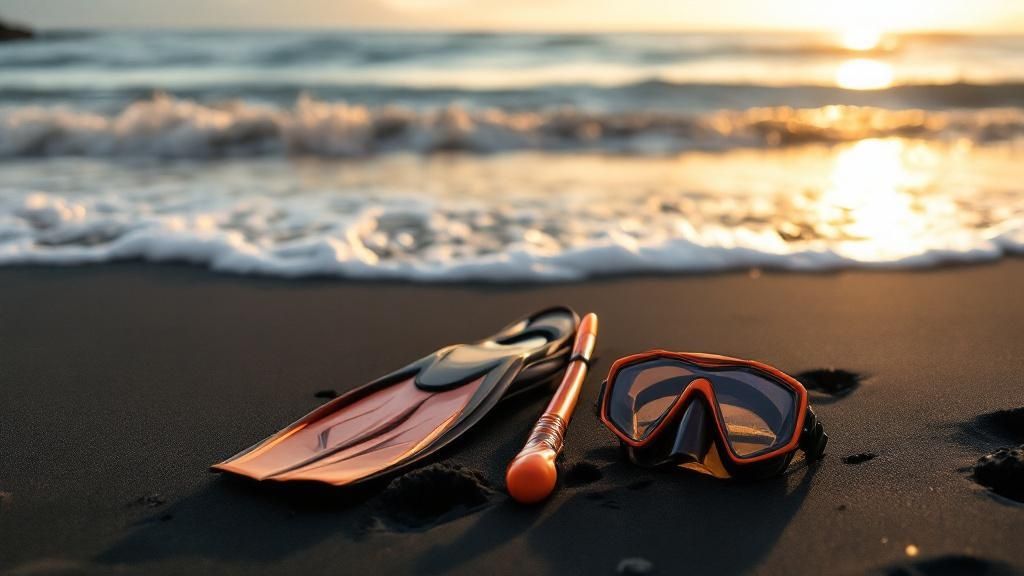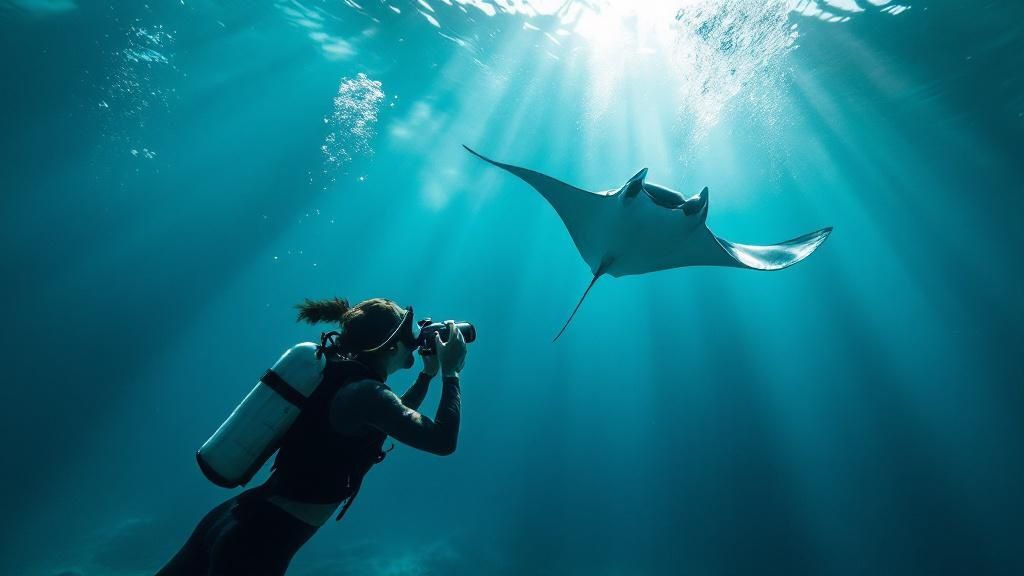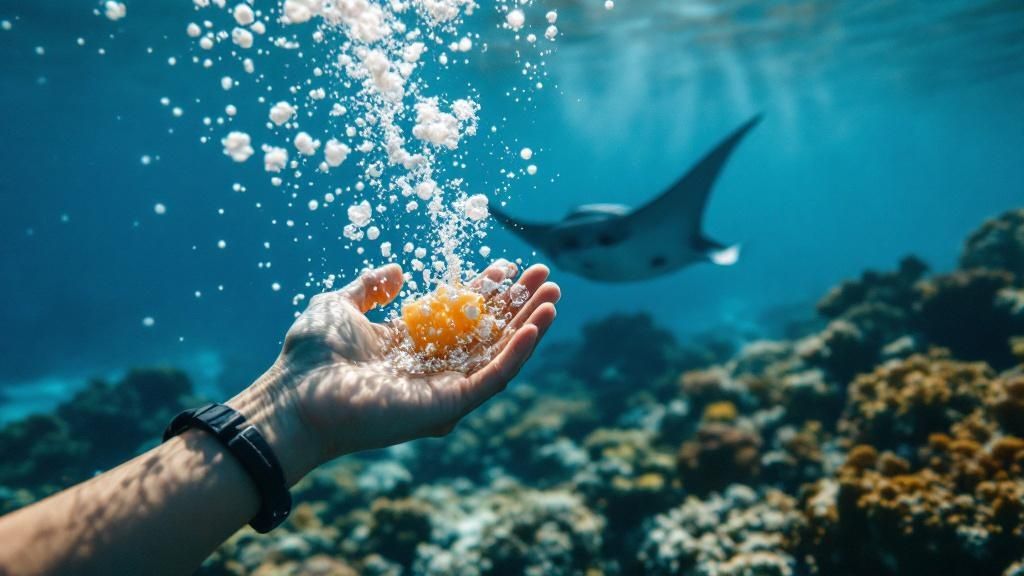Manta Ray Snorkel Big Island | Explore Magical Ocean Encounters
- Byron
- Aug 3
- 11 min read
Picture this: you're floating on the surface of the warm, dark Pacific Ocean. Below you, illuminated by gentle lights, giant manta rays perform a graceful, silent ballet. This is the magic of the manta ray snorkel on the Big Island, an ocean encounter that’s genuinely hard to put into words and something you’ll never, ever forget.
The Kona coast isn't just a good spot for this; it's one of the most reliable places on the entire planet to witness this incredible natural show, making it a can't-miss adventure for anyone visiting the island. At Manta Ray Night Snorkel Hawaii, we're proud to share this experience with visitors. See what our past guests have to say:
Your Guide to an Unforgettable Ocean Encounter
The Big Island offers a truly special chance to get up close with these majestic creatures right where they live. While sightings in other parts of the world can be a bit hit-or-miss, the unique conditions off the Kona coast have created a consistent feeding area that draws these gentle giants in almost every single night. If you want a deep dive into what makes this trip so incredible, be sure to read our ultimate guide to manta ray encounters.

What you’re seeing isn't just a tour; it's a front-row seat to a spectacular natural event. The tour boats position themselves and shine bright lights down into the water. This light attracts swarms of plankton, which happens to be the manta rays' favorite meal. It's like ringing a dinner bell, and the mantas show up for the feast, putting on an amazing show right in front of you.
Picking a tour operator that is both reputable and eco-conscious is key to having a great time while also being responsible. Companies like Manta Ray Night Snorkel Hawaii are committed to providing trips that are not only safe and educational but also deeply respectful of these amazing animals and their ocean home.
There's simply nothing like the feeling of a manta ray, with a wingspan that can be over 12 feet wide, gliding just inches beneath you. They move with a quiet elegance that seems impossible for their size, creating a peaceful, mesmerizing, and utterly beautiful underwater world.
Ready to book your own magical encounter?
Why Kona Is the World's Manta Ray Capital
So, what makes the Kona coast the absolute best place on the planet for a manta ray snorkel? It's not just random luck. It’s a perfect storm of geology, biology, and a bit of clever human intervention that creates a reliable and truly magical nightly show. This isn't your average wildlife tour where you cross your fingers and hope for the best—it's a consistent natural event.

The real secret is hidden just beneath the waves. The Big Island’s underwater landscape, carved out by volcanoes, has steep drop-offs very close to the shore. This unique geography causes deep, nutrient-rich water to get pushed upwards, which fuels a massive bloom of plankton. And for manta rays, that's an all-you-can-eat buffet.
Because the food is so plentiful, the mantas don't need to wander far. They’ve set up shop right along the coast, becoming year-round residents instead of just seasonal tourists passing through.
The Dinner Bell Effect
Over the years, tour operators figured out how to make this natural buffet even more appealing. They shine powerful, bright lights into the water, creating a beacon that plankton simply can't resist.
Think of it like a giant "dinner bell" ringing across the ocean. The light pulls in the plankton, and the huge concentration of plankton brings in the hungry mantas, leading them right to the snorkelers for an unforgettable feast.
This simple technique is the key to why the sightings are so incredibly reliable. It takes a natural feeding behavior and turns it into a predictable and breathtaking performance, allowing for up-close encounters almost every single night.
Unmatched Sighting Reliability
The sheer consistency of seeing mantas here is what truly makes the manta ray snorkel Big Island experience stand out. While you might get lucky with seasonal sightings in other parts of the world, Kona’s encounters are practically a nightly guarantee. In fact, operators regularly report an astounding 85-90% success rate for manta sightings on their night tours.
This isn’t a fluke; it's a finely-tuned ecosystem. The combination of resident mantas, abundant plankton, and the smart use of lights has cemented Kona's reputation as the world's premier manta ray destination. It's a dependable spectacle that has rightfully earned the coast its title.
How To Choose Your Perfect Manta Ray Tour
Picking the right tour operator for your manta ray snorkel on the Big Island is probably the single most important decision you'll make. It’s what separates a good trip from a truly incredible one. With so many companies out there, it’s easy to get overwhelmed, but knowing what to look for will help you find an unforgettable encounter instead of a crowded, rushed experience. The trick is to look past the price tag and focus on things like the size of the boat, how many people they take out, and their commitment to safety and the environment.

The best operators care just as much about the manta rays' well-being as they do about your fun. When you go with a company known for its eco-friendly practices, like Manta Ray Night Snorkel Hawaii, you can rest easy knowing your adventure is helping protect these gentle giants. But you don't have to take our word for it—see what other snorkelers have to say.
Small Boat vs. Large Boat Tours
One of the first forks in the road you'll encounter is choosing between a small-group tour and one on a larger vessel. Each offers a completely different vibe, so what’s "best" really comes down to what you're looking for in an evening on the water.
Smaller boats tend to feel more personal and less crowded. On the other hand, bigger boats often come with more amenities and are more stable if the water gets a little choppy.
Think of it like choosing between a private dinner party and a lively banquet. Both can be fantastic, but they offer completely different atmospheres. Your perfect manta ray snorkel experience depends on which setting feels right for you.
To help you figure out what fits your style, let’s break down what you can generally expect from each type of tour.
Comparing Big Island Manta Ray Tour Options
This table gives a quick snapshot of the trade-offs between smaller, more intimate tours and their larger, more social counterparts.
Feature | Small Group Tours | Large Group Tours |
|---|---|---|
Atmosphere | Intimate and personal, often feeling like a private excursion. | More social and bustling with higher energy. |
Guide Interaction | More one-on-one time with guides for questions and personalized help. | Less individual attention due to a higher guest-to-guide ratio. |
Crowding | Fewer people in the water, offering more space to view the mantas. | Can be more crowded around the light board. |
Boat Amenities | Typically fewer amenities; the focus is on the core experience. | Often have more space, restrooms, and other comforts. |
Stability | Smaller vessels like zodiacs can be a faster, bumpier ride. | Larger catamarans provide a very stable and smooth ride. |
Ultimately, there isn't a single "best" option—just the one that's best for you and your group. Whether you lean towards the close-knit feel of a small tour or the amenities of a larger boat, the most important thing is to choose a licensed, insured, and eco-conscious operator. Always make sure they provide all the gear you'll need, especially wetsuits, and have clear safety procedures in place.
So, you’ve booked your trip. What actually happens on a manta ray night snorkel? Knowing the play-by-play can turn any pre-trip jitters into pure, unadulterated excitement. From the moment you arrive at the dock to slipping into the dark, plankton-rich water, the whole thing is a finely-tuned adventure built for maximum wonder and safety.
When you join us for a manta ray snorkel on the Big Island, your evening starts with a warm aloha and a thorough safety briefing from our seasoned guides. We'll make sure you're comfortable and know exactly what's going on before we even leave the harbor.

The boat ride out to the manta site is an experience in itself. You’ll head out as the sun starts to set, often treating you to a classic, fiery Kona sunset over the Pacific. Once we get to the perfect spot and anchor, the crew sets up our custom-made light board. This isn't just a simple raft; think of it as your floating, front-row ticket to the main event.
Entering the Manta Theater
When it's time, you'll slide into the water and find a comfortable spot to hold onto the light board. It’s buoyant, so you can just relax and float. The powerful lights beam down into the dark water, which does two things: it lights up the stage and, more importantly, it attracts clouds of plankton. We call this the "manta buffet."
And then, you wait. It's a quiet, anticipatory moment.
Before long, you’ll see them—huge, graceful shadows ascending from the depths. These are Kona's famous manta rays, arriving for their nightly feast. It’s hard to describe the feeling of seeing them for the first time. These gentle giants, with wingspans reaching up to 14 feet, perform an incredible underwater ballet. They glide, swoop, and do barrel-rolls right below you, sometimes just inches away, filtering the water with their giant mouths.
It’s a completely passive experience for you. There's no swimming or chasing involved. You just float, hold on, and watch one of nature's most majestic creatures put on a show in the spotlight we’ve created. The world goes silent, and it's absolutely mesmerizing.
The Kona coast is home to over 450 identified manta rays, and this all happens in fairly shallow water, which is why it’s such a perfect experience for snorkelers. You’ll typically be in the water for about 45 to 60 minutes—plenty of time to soak in the spectacle. You can discover more about our local manta population and what makes these encounters so special.
Once the show wraps up, you’ll climb back onto the boat for a warm ride to shore, buzzing with the memory of one of the planet's most unforgettable wildlife encounters.
Keeping You and the Manta Rays Safe
When you go on a manta ray snorkel on the Big Island, you're stepping into the world of wild animals. It's an incredible privilege, and with it comes the responsibility to make sure we’re all safe—both you and the mantas.
Following a few simple, respectful rules helps protect these amazing creatures for years to come. Your guides will give you a full safety talk before you get in the water, but knowing the basics ahead of time will make the whole experience smoother and more enjoyable for everyone.
The number one rule is the most important one: never, ever touch the manta rays. It’s an absolute. These gentle giants have a delicate, slimy coating on their skin that protects them from nasty bacteria and infections. Think of it as their immune system. Even a gentle touch can rub it off, leaving them vulnerable to getting sick.
Be a Passive Observer
The best way to interact with the mantas is, well, not to interact at all. We call this "passive observation." You're there to watch the magic happen, not to be a part of the action. Imagine you're a guest in their underwater home—you wouldn't start rearranging the furniture, right? You'd just admire the view.
Here’s how you do it:
Stay at the Surface: You'll be holding onto a big floating light board. Your job is to stay there. Don't dive down toward the mantas, as that can disrupt their feeding and scare them off.
Keep Your Feet Up: Let your legs float flat on the surface behind you, like you're just relaxing in a pool. Kicking down could accidentally hit a manta as it glides right underneath you.
No Chasing: It can be tempting, but never chase, grab, or try to ride a manta. Let them come to you.
Let Them Run the Show: The mantas will swoop, glide, and do barrel rolls right in front of you. All you have to do is float and watch. By giving them space, you let them feel comfortable enough to put on their spectacular natural display.
When you're a calm, passive observer, you become part of the scenery instead of an intruder. This not only keeps the mantas safe but also makes the encounter far more authentic and magical for you.
Choosing a tour operator that takes these rules seriously is key. Look for companies that are 'Manta SMART' certified, which means they follow strict, eco-friendly guidelines. To learn more about how these tours keep both people and mantas safe, check out our complete Big Island night tour guide.
By booking with a responsible company, you’re doing more than just having an amazing time—you're helping protect Kona's incredible manta ray population.
When Is the Best Time for Your Snorkel Adventure?
One of the first questions people ask is, "When should we book our manta ray snorkel on the Big Island?" The great news? This is a year-round adventure. The manta rays along the Kona coast are residents, not tourists, meaning they stick around all year. This gives you a fantastic shot at seeing them no matter when you plan your trip.
And that's not just a hopeful guess—it's backed by solid research. Years of monitoring the Kona manta population have shown just how consistent these sightings are. One long-term study found that mantas show up six to seven nights per week, a level of reliability you just don't find in most other manta spots around the globe. You can dive into the numbers yourself by checking out the manta ray activity statistics.
What this really means is that you can book your trip with confidence, knowing a truly magical encounter is very likely any night of the year.
Timing for Optimal Conditions
While the mantas are always here, a couple of small details can turn a great experience into an absolutely perfect one. Thinking about these can help you pick the best possible time for your trip.
Ocean Conditions: The summer months, generally from May through September, tend to have the calmest seas. If you're someone who gets a bit seasick, this could be the sweet spot for your visit.
Moon Phases: It might sound strange, but a darker night can make the show even more spectacular. Around the new moon, the sky is pitch black. This makes our boat's underwater lights extra powerful magnets for the plankton that manta rays love to eat.
Honestly, the best time to see the mantas is whenever you can get here. The success rate is so high that any night is a good night for a potential show.
No matter the time of year or phase of the moon, the heart of the experience is always breathtaking. To get a better feel for what it's all about, take a look at our guide on how to experience the magic of the Big Island manta snorkel.
Your Questions Answered
Still have a few questions floating around about your manta ray snorkel Big Island trip? That’s completely normal. Let’s clear up some of the most common things people ask before they book.
It’s natural to wonder about safety and what you need to be able to do physically, especially for a unique night adventure like this. We get it. The goal is for you to feel completely comfortable so you can soak in every magical moment.
Do I Need to Be a Strong Swimmer for This Tour?
Not at all, and that’s what makes this experience so accessible. You won’t be swimming around freely. Instead, you'll be holding onto a large, custom-made light board that floats on the surface.
The board gives you all the stability you need, and your wetsuit adds a surprising amount of buoyancy. Honestly, as long as you're okay with putting your face in the water while wearing a snorkel mask, you're good to go. It’s much more about floating and observing than it is about swimming.
Is the Manta Ray Night Snorkel Safe?
Yes, it’s very safe, especially when you choose a professional, certified company like Manta Ray Night Snorkel Hawaii. Manta rays themselves are true gentle giants—they have no teeth, no stingers, and no barbs. They are only there for the plankton drawn to the lights.
On top of that, every tour kicks off with a detailed safety talk. Your expert guides are right there in the water with you the entire time, making sure everything runs smoothly and everyone stays safe.
What Should I Bring on My Tour?
Keeping it simple is the way to go. The absolute must-haves are a towel and a set of warm, dry clothes to change into for the boat ride back to the harbor.
Your tour operator will provide all the gear you need, from high-quality masks and snorkels to the wetsuits. It’s also a smart move to bring a reusable water bottle. And if you know you’re prone to motion sickness, you might want to take your preferred remedy beforehand as a precaution.
While sightings are incredibly consistent (we're talking over 90% success rates), it's important to remember these are wild animals. That's why many great companies offer a "manta guarantee." If your tour doesn't see any mantas, you can usually come back for free on another night. Just be sure to ask about the specific policy when you book!
Ready to see them for yourself?
Comments